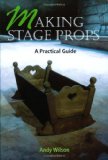

This is a story about Making Stage Props: A Practical Guide. A very good story indeed.
This book is tailor-made to anyone who works as a props artisan. In many ways, it is the book I wish I had when I first started out as a props carpenter. It does not talk about shopping, or organizing a prop list, or talking with directors. It is not a collection of tips and tricks used by props people, such as breakable glasses, blood knives, or fake food. Quite simply, it deals with how to construct props the way a professional prop shop constructs props. For the most part, that means furniture, though it also includes examples of large decorative pieces, masks, and some weaponry.
Because it deals with more tried-and-techniques (and it was written in 2003), it is one of the most up-to-date books about making stage props you can find.
Wilson divides the chapters by material and/or process: wood, steel, modelling, making moulds, casting and laminating, expanded polystyrene, upholstery, and paints and finishes. So while you can read the book from cover-to-cover, it works just as well as a reference which you can refer back to over and over again, depending on what your next project is. I would, however, recommend reading the introduction first. I had a strong sense of déjà vu the first time I read it; the way Wilson describes approaching a project is similar to what I wrote in my paper for the SETC Theatre Symposium. Guess that means I’m on to something
As you may have noticed from his spelling of “moulds” above, Wilson is British. The book is still highly useful even with a few linguistic and cultural differences—20mm plywood instead of 3/4″, for example.
The photographs, though all black-and-white, are very clear. He also includes a lot of diagrams and illustrations. Obviously, a book on prop-making can never hope to contain all the materials and processes one can ever use; he does, however, cover the most common ones which can be used to build probably 90% of the props you will ever build for the stage. Some of the information he includes can be oddly specific; for example, in the chapter on “wood”, he includes a diagram for a lathe, with all the parts listed. This is the only tool that gets such a diagram in that chapter. Why? I’m not sure.
Overall, the amount of information Wilson packs into this compact book is amazing, and it has something for prop-makers of all skills, whether new to the field, or experienced artisans. I feel strongly that it is one of the few “necessary” books for prop-makers, and even for prop people in general.




